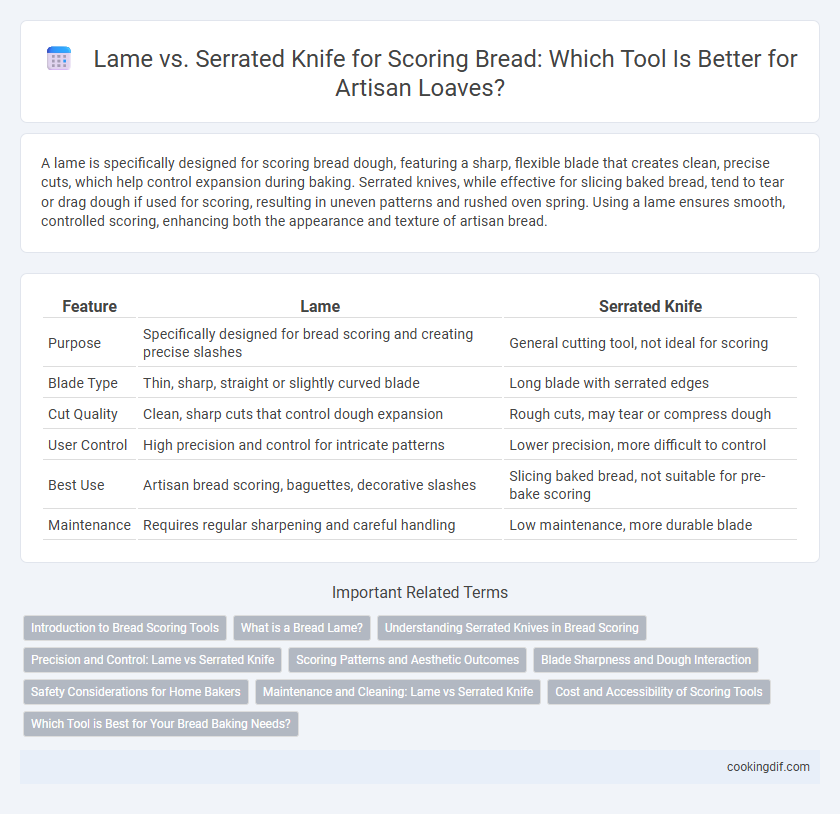A lame is specifically designed for scoring bread dough, featuring a sharp, flexible blade that creates clean, precise cuts, which help control expansion during baking. Serrated knives, while effective for slicing baked bread, tend to tear or drag dough if used for scoring, resulting in uneven patterns and rushed oven spring. Using a lame ensures smooth, controlled scoring, enhancing both the appearance and texture of artisan bread.
Table of Comparison
| Feature | Lame | Serrated Knife |
|---|---|---|
| Purpose | Specifically designed for bread scoring and creating precise slashes | General cutting tool, not ideal for scoring |
| Blade Type | Thin, sharp, straight or slightly curved blade | Long blade with serrated edges |
| Cut Quality | Clean, sharp cuts that control dough expansion | Rough cuts, may tear or compress dough |
| User Control | High precision and control for intricate patterns | Lower precision, more difficult to control |
| Best Use | Artisan bread scoring, baguettes, decorative slashes | Slicing baked bread, not suitable for pre-bake scoring |
| Maintenance | Requires regular sharpening and careful handling | Low maintenance, more durable blade |
Introduction to Bread Scoring Tools
A lame is a specialized bread scoring tool featuring a sharp, replaceable blade designed specifically for precise slashes on dough, promoting controlled expansion during baking. Serrated knives, often used as a versatile kitchen tool, tend to tear dough irregularly, compromising the aesthetic and texture of the bread crust. For optimal bread scoring, the lame offers superior control and clean cuts, essential for artisan bread presentations.
What is a Bread Lame?
A bread lame is a specialized baking tool featuring a thin, sharp blade attached to a handle, designed specifically for scoring dough before baking. This tool allows precise, clean cuts that control the bread's expansion and create decorative patterns on the crust. Unlike serrated knives that can tear the dough, the lame's razor-sharp edge ensures smooth incisions, improving both the appearance and texture of artisan bread.
Understanding Serrated Knives in Bread Scoring
Serrated knives feature a saw-like edge that excels at cutting through the crust of bread without compressing the dough, making them effective for scoring artisan loaves. Unlike lame blades, serrated knives provide controlled incisions that help dough expand evenly during baking, preventing irregular crust ruptures. Their design minimizes drag and preserves the shape of the bread, contributing to a professional appearance and optimal crumb structure.
Precision and Control: Lame vs Serrated Knife
A lame offers superior precision and control for scoring bread dough due to its thin, sharp blade designed explicitly for making clean, deliberate incisions that promote even expansion during baking. In contrast, a serrated knife tends to tear the dough's surface, resulting in less precise cuts and uneven oven spring. For artisan bread scoring, the controlled, smooth slicing of a lame ensures optimal crust development and aesthetic appeal.
Scoring Patterns and Aesthetic Outcomes
Lame knives create precise, shallow cuts that enhance intricate scoring patterns, resulting in visually striking, artisanal bread crusts. Serrated knives often produce rougher edges, limiting detailed scoring and yielding a more rustic aesthetic. Choosing a lame ensures cleaner, controlled incisions that improve both oven spring and decorative appeal in bread baking.
Blade Sharpness and Dough Interaction
A lame features a razor-sharp, straight blade designed for precision scoring, allowing clean, controlled cuts that help dough expand evenly during baking. Serrated knives, with their saw-like edges, tend to tear the dough surface, resulting in uneven cuts that can negatively impact oven spring and crust texture. Sharpness in a lame ensures smooth blade-dough interaction, minimizing resistance and promoting optimal release of gases for a better loaf rise.
Safety Considerations for Home Bakers
Choosing between a lame and a serrated knife for scoring bread impacts home baker safety, as lames feature sharp, replaceable blades designed for precise, controlled cuts that reduce slipping risks. Serrated knives, while common in kitchens, can cause uneven pressure and slipping due to their thicker blades, increasing the chance of accidental cuts. Proper handling, using a stable surface, and keeping blades sharp enhance safety regardless of the chosen tool.
Maintenance and Cleaning: Lame vs Serrated Knife
A lame requires careful maintenance, including regular sharpening and drying to prevent rust and maintain its precise scoring ability. Serrated knives are more durable with less frequent sharpening needed but are harder to clean thoroughly due to food particles getting trapped in the serrations. Proper cleaning of both tools involves immediate rinsing and drying to ensure longevity and optimal performance in bread scoring.
Cost and Accessibility of Scoring Tools
Lame knives, specifically designed for scoring bread dough, tend to be more expensive and less accessible than serrated knives, making them a premium choice for serious bakers. Serrated knives, widely available and affordable, offer a practical alternative for home bakers looking to score dough effectively without investing in specialized tools. Bread scoring performance varies between these tools, but accessibility and cost often guide the decision for casual versus professional use.
Which Tool is Best for Your Bread Baking Needs?
A lame, designed specifically for scoring bread, provides precise and clean cuts that control the expansion of dough during baking, resulting in an attractive crust and enhanced oven spring. Serrated knives, while multipurpose and effective for slicing finished breads, lack the sharpness and control required for scoring live dough without damaging its structure. For bakers seeking optimal results in shaping and controlling their loaf's rise, investing in a sharp, adjustable lame is the superior choice over a serrated knife.
Lame vs Serrated knife for scoring Infographic

 cookingdif.com
cookingdif.com